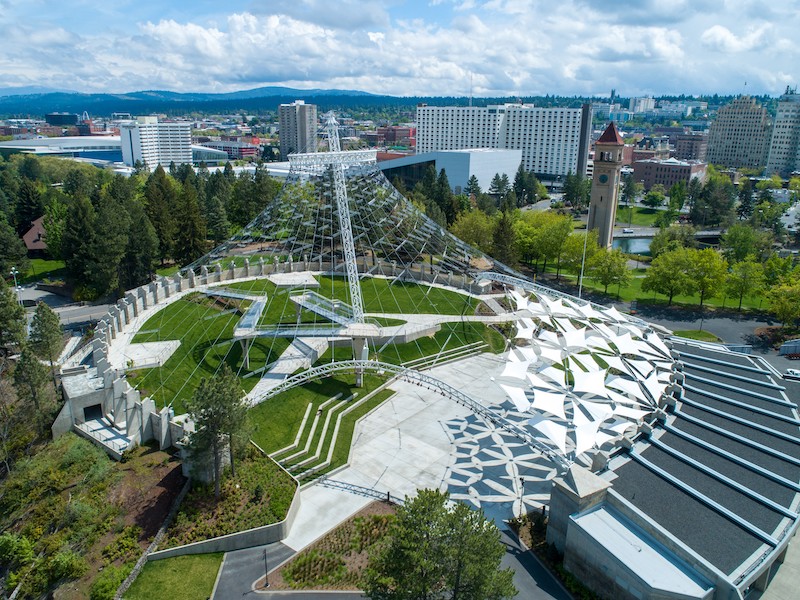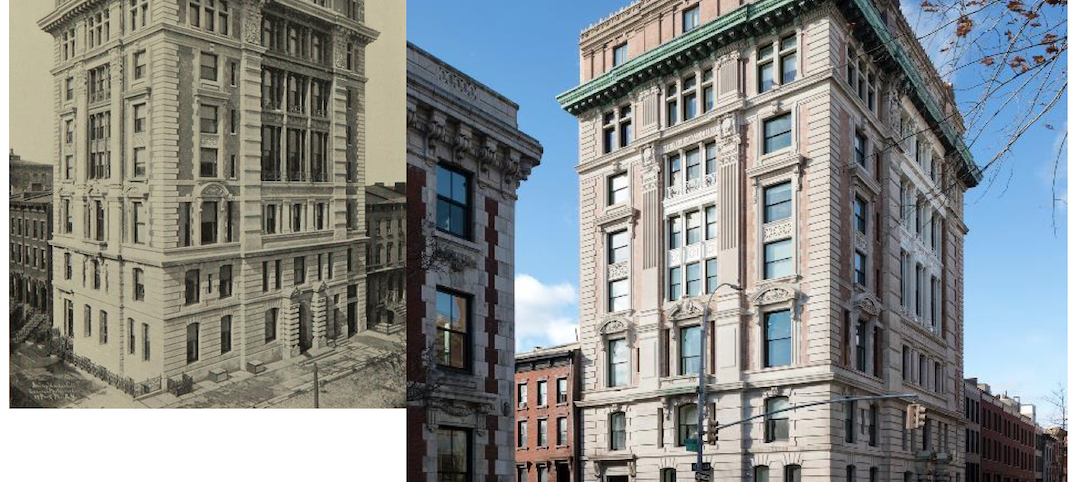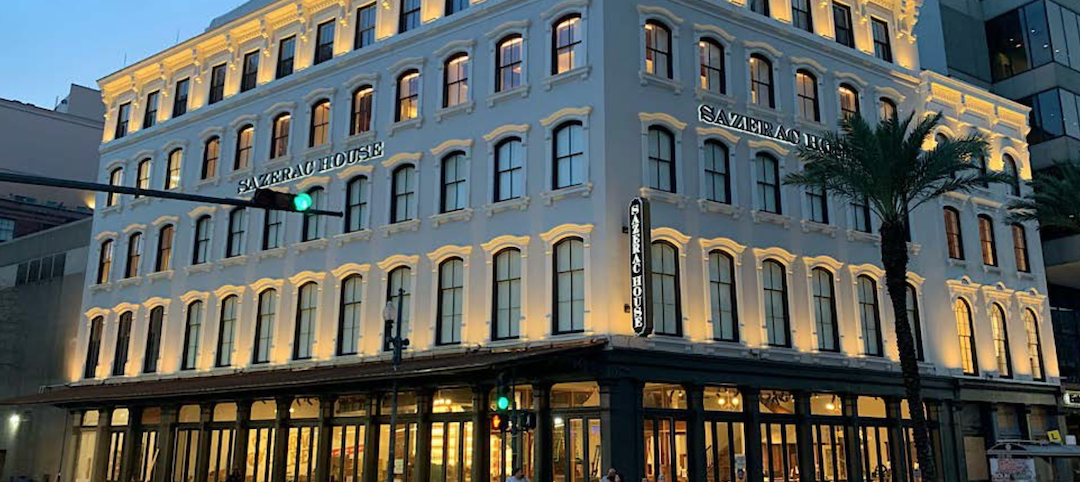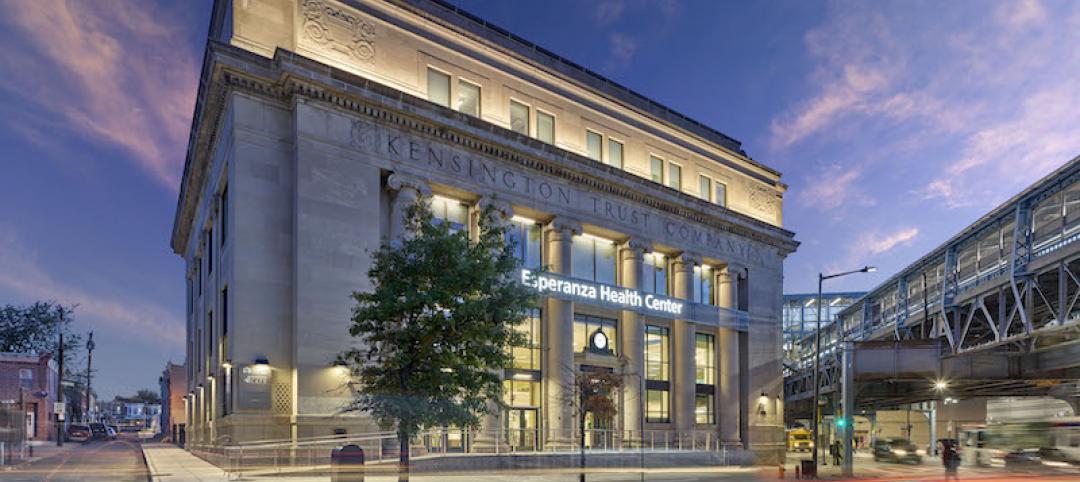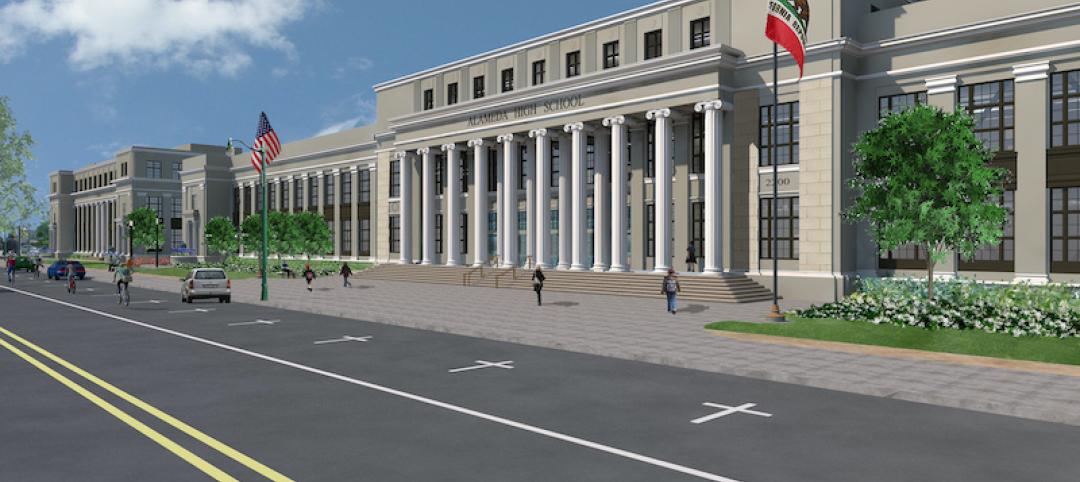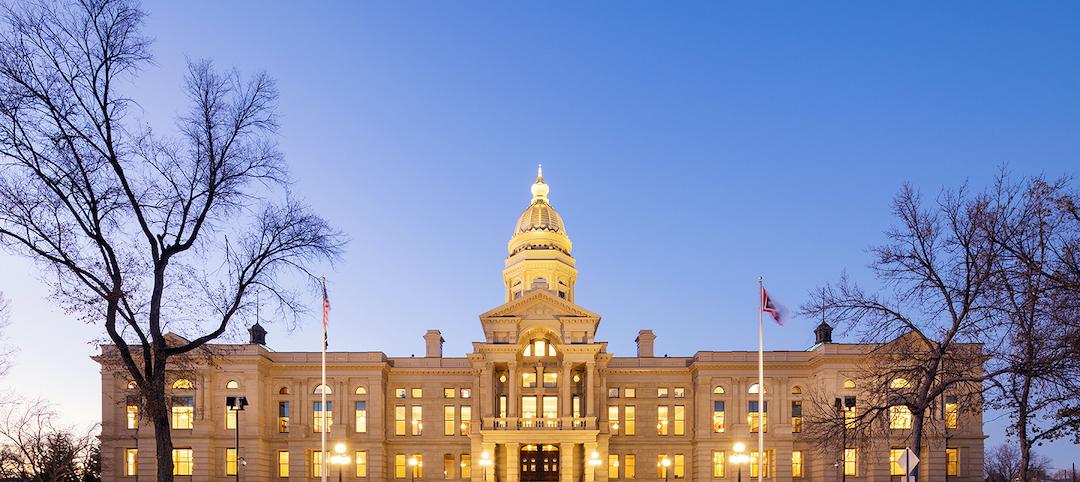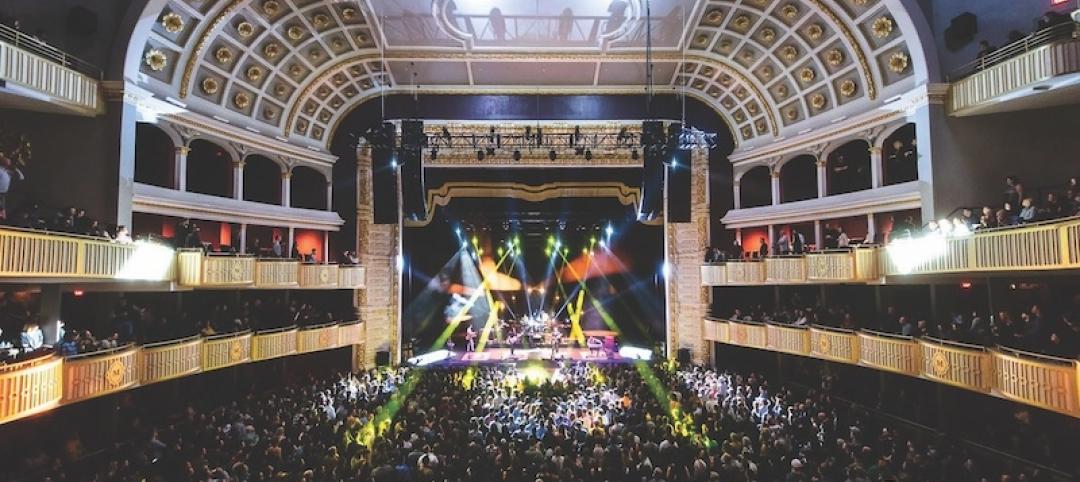Situated at the center of Riverfront Park on Havermale Island in Spokane, Wash., the U.S. Pavilion had become a beacon of indecisiveness for the area. Built by the federal government for the 1974 World’s Fair, and gifted to the city of Spokane after, the vision of how to best utilize the space changed numerous times throughout the years without any one vision coming to fruition. This led to the pavilion grounds becoming cluttered with underutilized buildings and structures.
As part of a modernization project for Riverfront Park, the City of Spokane Parks and Recreation Department decided to update the pavilion and turn it into a central gathering point for hosting community-oriented events. The new U.S. Pavilion was also envisioned as a lantern at night, illuminated with state-of-the-art lighting and project technology to attract visitors and tourists.
The Pavilion comprises a 150-foot-tall, angled mast that supports a 50-foot diameter steel ring. A cable-net structure attached to the ring extends downward to a circular-buttressed concrete wall and columns. The cable-net structure was originally covered and resembled a large tent, but this cover was removed only a few years after construction after being shredded by the wind. For the new U.S. Pavilion, the Build Team decided to forgo the tent-like canopy, as it would have greatly compromised the ability for the structure to serve as a lantern at night, a decision that originally drew the ire of the public. But by clearly identifying and explaining the project’s goals of reconnecting to the river, providing illumination and shading, and creating an “Elevation Experience” that showcased the Park, the Build Team was able to win over the public.
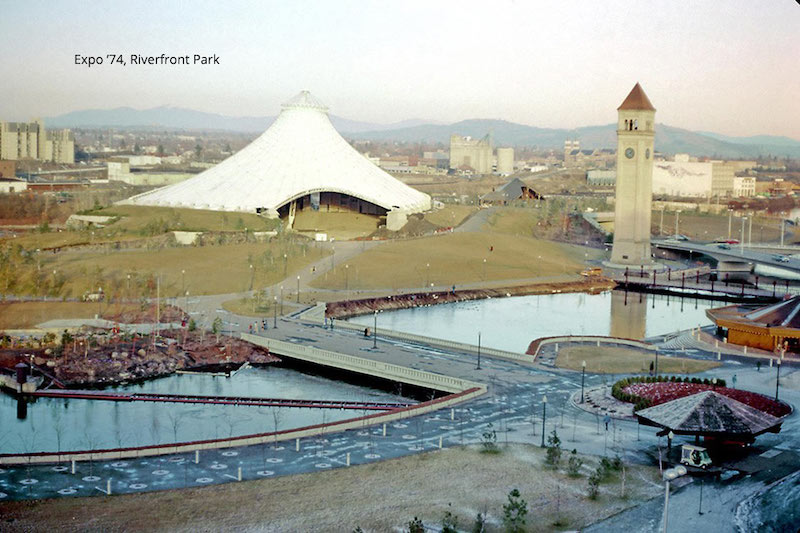 Photo obtained from NAC Architecture.
Photo obtained from NAC Architecture.
On the west side, and integral to the concrete wall, is a 16,000-sf, two-story concrete building. The reimagined project scope included removing all buildings added after 1974, renovating the west building, and creating an amphitheater below the cable-net structure.
In order to achieve the goal of turning the Pavilion into a lantern, the Build Team, after cycling through many early design concepts such as stinging the cable-net structure with Christmas lights, settled on using light blades consisting of LED modules in a robust luminaire housing attached to the cable structure with flexible mounting points. The luminaire system was designed to be subjected to a wide range of weather and temperature changes, as well as vibrations in the cable structure due to tension and wind.
Photo: Miles Bergsma.
The luminaire housing was completed with etched acrylic panels, which were designed and tested to create the desired lighting effect without precision aiming, thereby reducing the complexity of maintaining the system. Because the light-blade luminaires can accommodate movements and flexing without the need to re-aim, the need to access the luminaires was reduced to almost zero.
In addition to the lighting, providing shading for the events was another key programming challenge. GuildWorks, a design-build tension structure specialist, recommended attaching shade elements to the existing cable-net structure by reverse engineering the 46-year-old cable structure using modern tension structure analysis. The team then engineered and constructed a new system of struts, tension cables, and tensioned shade fabrics to support 72 custom-designed architectural fabric panels.
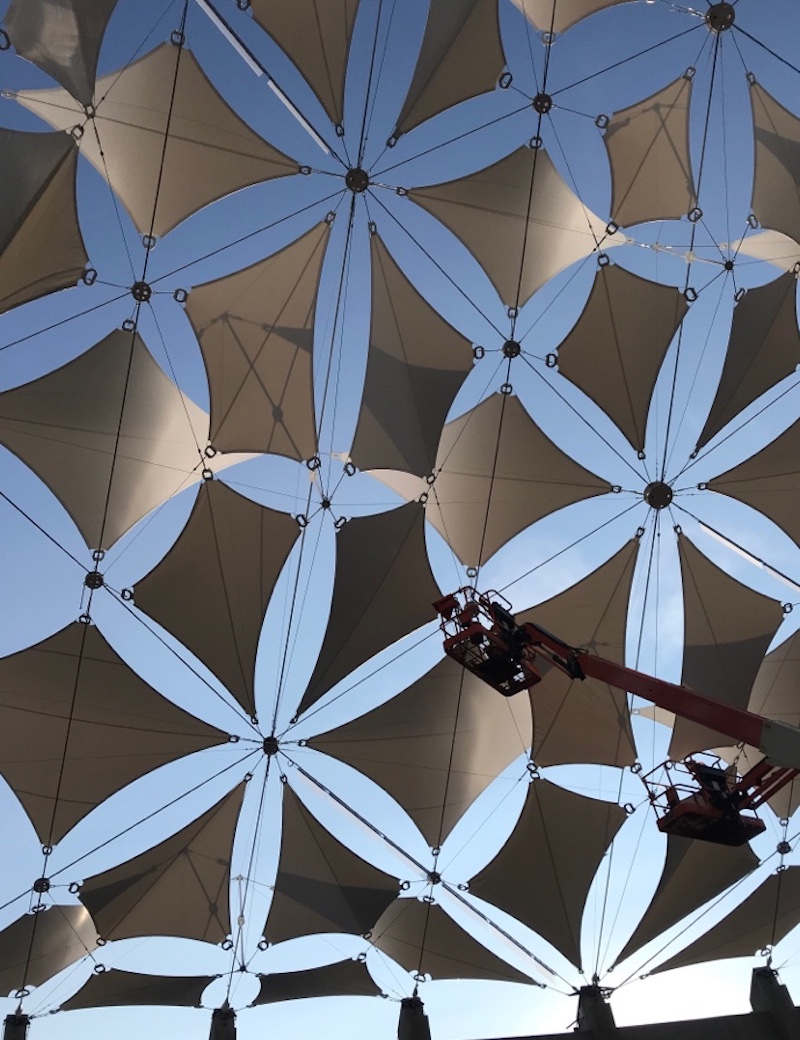 Photo: GuildWorks.
Photo: GuildWorks.
The shade panels are located on the lower western section of the U.S. Pavilion cabling. During afternoon sun the panels provide shade in an artistic pattern, casting abstract, Pavilion-like imagery, while also enhancing the vision of patrons looking west toward the stage. Carefully locating the panels ensured that visitors remain in sunlight during the cooler parts of the day.
The Elevated Experience, meanwhile, was designed and built with four guiding principles in mind:
1. Make it a “magnetic” attraction that will draw visitors in
2. Celebrate and connect the iconic structure
3. Provide views of the city and the river
4. Make it feel a bit precarious and uncomfortable
Photo: Miles Bergsma.
The Elevated Experience became a unique public space where visitors ascend under their own power up narrow walkways with largely transparent railings and see-through gratings as a walking surface. The height of the pathways allow for both views of the surrounding city and river, as well as below to the pavilion floor and its events.
The completed project delivered a reimagined U.S. Pavilion that exceeded all expectations despite significant initial opposition and challenges.
PROJECT INFORMATION: Size 86,000 sf Construction start and finish December 2017 to August 30, 2019 Cost $24.7 Million Delivery method Design-Build
BUILDING TEAM: Submitting firm Hill International, Inc. Owner/Developer City of Spokane Parks and Recreation Department Architect NAC Architecture Architect of Record Berger Partnership SE DCI Engineers Mechanical nad Plumbing Engineer MW Consulting Engineers Electrical Engineer NAC Electrical and Lighting GC Garco Construction Program Manager Hill International, Inc.
Related Stories
Reconstruction Awards | Jan 6, 2021
University of Pennsylvania’s Stemmler Hall forgoes retrofit in favor of complete renovation
The Edward J. Stemmler Hall project has won a Bronze Award in BD+C’s 2020 Reconstruction Awards.
Reconstruction Awards | Dec 29, 2020
The reenvisioned Sazerac House: A delectable cocktail that's just perfect for the Big Easy
The 51,987-sf Sazerac House is an interactive cocktail museum, active distillery, corporate headquarters, and event venue, all under one roof, next to the historic French Quarter of New Orleans.
Reconstruction Awards | Dec 18, 2020
Can converting a landmark office to a clinic raise up a downtrodden Philadelphia neighborhood?
BD+C’s Reconstruction Awards recognize the adaptive reuse of the Kensington Trust building.
Reconstruction Awards | Dec 16, 2020
Voters resuscitate an abandoned high school in northern California
A 2014 bond issue provided financing to seismically stabilize and modernize Historic Alameda High School, a 2020 Silver Reconstruction Award winner.
Reconstruction Awards | Dec 14, 2020
Wyoming Capitol Square renovation project is all about the details
The Wyoming Capitol Square project has won a Gold Award in BD+C's 2020 Reconstruction Awards.
Reconstruction Awards | Dec 12, 2020
A famed dome of a historic glasshouse is revived to its rightful glory
Scaffolding played a critical role in the repair and restoration of the Enid A. Haupt Conservatory’s Palm Dome at the New York Botanical Gardens, a Gold winner of BD&C’s 2020 Reconstruction Awards
Reconstruction Awards | Dec 8, 2020
A synagogue in Toronto is renewed while preserving its history
Holy Blossom Temple is a Platinum winner in BD+C’s 2020 Reconstruction Awards.
Reconstruction Awards | Dec 19, 2019
BD+C's 2019 Reconstruction Award Winners
The Museum at the Gateway Arch, the Senate of Canada building, and Google, Spruce Goose are just a few of the projects recognized with 2019 Reconstruction Awards.


